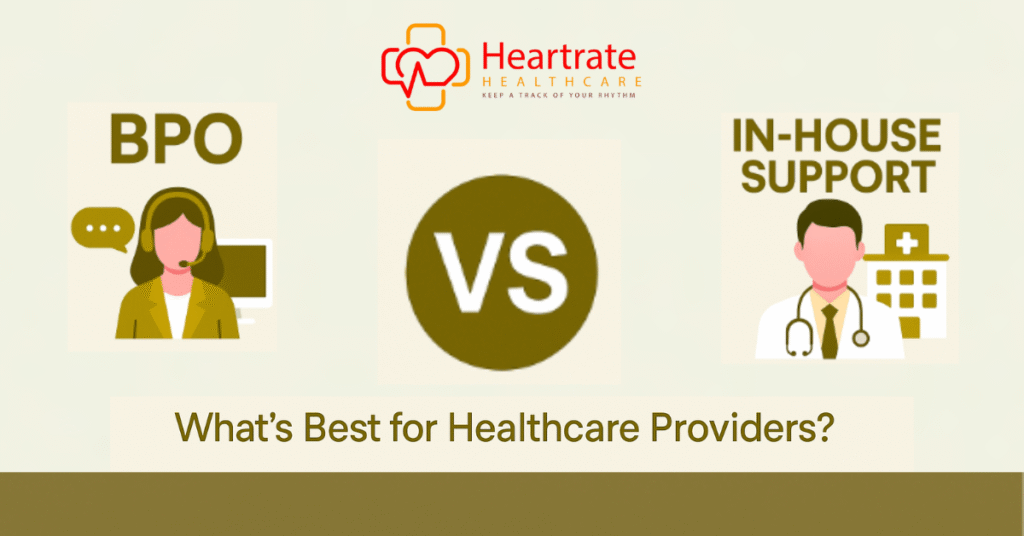In today’s rapidly evolving healthcare environment, efficiency, quality, and cost-effectiveness are paramount. With administrative and operational demands growing, healthcare providers face a vital decision—whether to manage support services in-house or outsource them through a Business Process Outsourcing (BPO) partner. Each approach carries its own set of benefits and challenges. This article explores both models to help healthcare organizations make an informed choice.
Understanding BPO in Healthcare
Business Process Outsourcing (BPO) refers to delegating certain business operations—such as billing, customer service, or IT support—to third-party vendors. In healthcare, BPO is often used for:
-
Revenue Cycle Management (RCM)
-
Medical transcription
-
Appointment scheduling
-
Claims processing
Advantages of BPO in Healthcare
-
Cost Savings
Outsourcing eliminates the need for infrastructure, recruitment, and training. BPO partners often operate in regions with lower labor costs, which can reduce operational expenses by up to 60%. -
Focus on Core Competencies
Delegating non-core tasks enables healthcare providers to focus on patient care, medical innovation, and clinical excellence. -
Scalability & Flexibility
BPO providers offer the ability to scale services quickly based on seasonal demand or sudden business growth without hiring new staff. -
Access to Expertise & Technology
Leading BPO vendors bring industry-specific experience and advanced tools, offering high accuracy and compliance with HIPAA and other healthcare regulations.
Challenges of BPO in Healthcare
-
Lack of Direct Control
Outsourcing means relinquishing some level of control, which can affect the speed of response or customization. -
Data Security Risks
Healthcare data is highly sensitive. A third-party vendor must comply strictly with data protection norms, or there could be legal and reputational consequences. -
Cultural & Communication Gaps
Language barriers or time zone differences can affect communication between your internal team and the outsourced staff.
Understanding In-House Support
In-house support involves hiring and managing internal teams to handle business operations. It includes:
-
On-site billing and administrative staff
-
Internal IT support
-
Call center representatives within the hospital
-
HR and compliance teams
Advantages of In-House Support
-
Greater Control
You can manage quality, workflows, and service standards directly. This is particularly important for functions that impact patient care or experience. -
Stronger Team Integration
In-house teams are more aligned with the organization’s values, mission, and culture. They often exhibit higher accountability and ownership. -
Better Customization
Processes can be tailored more easily to your organization’s specific needs without negotiating service-level agreements.
Challenges of In-House Support
-
Higher Operational Costs
Salaries, benefits, training, and infrastructure create significant fixed costs that can burden smaller healthcare providers. -
Resource Constraints
It can be challenging to hire specialized talent or scale operations quickly without additional investment. -
Limited Technological Access
Not all healthcare organizations have the budget to deploy state-of-the-art tools and automation used by BPO providers.
Comparative Overview
| Feature | BPO | In-House Support |
|---|---|---|
| Cost | Lower | Higher |
| Control | Limited | High |
| Scalability | High | Moderate |
| Customization | Moderate | High |
| Security Risk | Higher (external) | Lower (internal) |
| Speed to Implement | Fast | Slower |
| Compliance | Dependent on vendor | Fully managed internally |
Which One Should You Choose?
Choose BPO If:
-
You’re a small or medium-sized healthcare provider looking to cut costs.
-
You need rapid scalability or 24/7 support services.
-
You lack in-house tech or billing expertise.
Choose In-House If:
-
You prioritize control, patient data security, and cultural alignment.
-
You can afford the infrastructure and staffing costs.
-
Your processes are complex and require high customization.
Hybrid Model: A Balanced Approach
Many modern healthcare providers are now adopting a hybrid model. For example:
-
Outsourcing billing and appointment setting
-
Keeping patient engagement and medical queries in-house
This model allows you to optimize costs while retaining control over sensitive areas.
Conclusion
There is no one-size-fits-all solution when it comes to healthcare support systems. BPO and in-house models each offer unique advantages. At Heartrate Healthcare (HRHC), we believe in customizing support strategies based on the individual needs of each healthcare provider. Whether you choose to outsource, stay in-house, or adopt a hybrid model, your decision should ultimately support your mission to deliver better patient outcomes.


